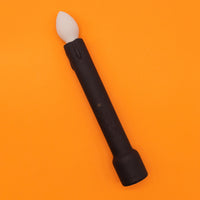Why Would You Want to Go Slow?
For many people – with apologies to Meghan Trainor – it’s all about that orgasm. That’s understandable for several reasons.- For starters, we’ve all been bombarded with magazine stories, TV shows and online blogs emphasizing the climax, completely overshadowing the other types of pleasure that sexual contact and intimacy can provide.
- Secondly, research has shown that both vulva-havers and penis-havers associate sexual satisfaction, and a healthy sex life, with the frequency and quality of the orgasms that they and their partners experience.
- Finally, climaxes feel incredibly gooood.
Slow Sex Can Be Better Sex
Let’s start with something that most people can agree on: the primary motivation to have sex is to feel good. And that means pleasure. The body has multiple erogenous zones. Most of them are often neglected, though, in the rush to get to the finish line. Perhaps the breasts or neck get a little attention during foreplay, but there are many other areas which can provide just as much pleasure. In fact, studies show that “tactile stimulation of practically all body regions may trigger sexual arousal.” And since the goal of sex play is pleasure, slower sex can be better – since it allows for greater arousal and maximum enjoyment. As B.B. Barratt said in the article “Sensuality, Sexuality and the Eroticism of Slowness,” published in the 2013 book Culture of the Slow: “Fast sex tends to be goal-oriented: I want to have an orgasm. I want to relieve tension.Slow Sex is Better for Vulva-Havers
Studies show that, on average, it takes vulva owners about 14 minutes to reach orgasm (and some research claims the average is much longer than that). Penis havers, on the other hand, average about five minutes to ejaculation during penetrative sex. How do you bridge that nine minute gap? Through extended foreplay and slower sex. Not only does that increase pleasure for both partners, it gives vulva haver(s) enough time to climax, ensuring maximum enjoyment all around. Slow sex is even more of a boon to those who experience delayed orgasm or are anorgasmic (generally unable to have orgasms). It allows greater satisfaction during sex, along with a greater possibility of achieving climax – or at least coming close. Some sexologists, who belong to what’s called the “slow sex movement,” preach the benefits of slowing things down for all vulva-havers. Perhaps the best-known is Nicole Daedone, who promotes what she describes as the practice of Orgasmic Meditation (OM) in the book Slow Sex: The Art and Craft of the Female Orgasm. Daedone says that OM leads to “authentic female sexual satisfaction.” In a nutshell, however, it’s really the sexual version of mindfulness, allowing both partners to experience a deeper spiritual and physical connection during prolonged sexual experiences. Some of the elements (and benefits) of OM are similar to those of tantric sex, which is much more than a Kama Sutra-style catalog of different sex positions. Sex therapists who are also tantra educators recommend non-contact practices like synchronized breathing, sustained eye contact, “motionless intercourse” and sex without orgasm, to increase couples’ intimacy and levels of sexual satisfaction.Slow Sex Leads to Better Orgasms
Anticipation builds excitement, whether you’re counting down the minutes to a concert or waiting to consummate sexual desire. The longer you draw out a sexual encounter, the greater the amount of anticipation that builds, the greater the excitement will be – and, research shows, the stronger the orgasm(s) are likely to be. The research was done primarily to explore ways to treat sexual dysfunction. However, the technique variously known as orgasm control, the “start-stop method,” or “edging” is growing in popularity for the same basic reason: it leads to stronger orgasms. It works by keeping partners on the “edge” of orgasm for a prolonged period of time, while their excitement continues to build. Edging is primarily done during slow intercourse. But it’s just as productive when it only involves a vulva-haver, a clitoris and fingers (or sex toys like vibrators); or only a penis-haver, a hand and some lube. In reality, those who first practice orgasm control on their own are likely to have more success when their partner joins the party.Other Benefits of Slow Sex
There are other reasons to slow down your sex as well:- A quickie can feel like a letdown. After all, if you’ve been anticipating a sexual encounter all day, why focus on just the 15-60 seconds of an orgasm?
- After a while, many couples find that their sex has become ordinary or monotonous. Going slow can redefine sex by introducing new (or forgotten) levels and types of pleasure into the relationship.
- Most people live their lives in a hurry. Slow sex provides a welcome break from the pace of everyday life.
- Slow sex provides a connection that may be missing in the rush to orgasm. It can deepen the intimacy and emotional bonds necessary for truly satisfying sex lives.
How to Have Slow Sex
Compare these two situations. You’re driving down the street and realize you’re going 15 miles over the speed limit. Slowing down is pretty easy; you ease your foot off the gas pedal. But slowing down during sex isn’t that simple, since normal sexual behavior is developed through experience. It’s extremely difficult to just tell yourself to go slower, since that requires overcoming muscle memory and embedded instincts. The first time you try slow sex, you may even find yourself “at war” with what your body and mind are telling you to do. One of the best ways to overcome the problem is by changing some of the external stimuli or regular behaviors you associate with a sexual encounter. Here are some you may want to consider.External Factors
- Allow enough time: Spontaneity can add excitement (and a welcome rush of adrenaline) to a relationship. But slow sex will usually require much more time than you might have available, if you usually just grab your partner for a quick hookup when you each have a few minutes. You don’t have to mark “slow sex” on your calendar, but be sure to choose a time when you’ll be able to get fully involved in a leisurely but exciting session.
- Change locations: If sex with your partner usually means hopping into bed, try finding somewhere else comfortable for your first few experiences with slow sex. You’re likely to fall back into familiar (meaning quick) patterns if you’re in your “regular sex location.”
- Change up the environment: The same impulse to revert to familiar patterns can be triggered by the scent of the candle you usually light before sexytime, or even the amount of light coming in through the curtains. Try altering the sensory elements you’d normally experience during sex, to make slow sex seem like a different experience. One more pro tip: if you like music in the background, choose slow and sensual tunes instead of fast ones.
Sexual Behavioral Changes
- Hands off: Even if you have trouble keeping your hands off your partner, try. Hands-free mindful breathing exercises will allow you to relax, think in the moment, and focus. Studies show it can enhance sexual function, too. Don’t worry, there will be plenty of time for the actual sex – once you’ve slowed down your bodies and your instincts. Having trouble staying hands-off? Try focusing just on your partner’s eyes to imagine what they’re feeling. Use blindfolds to increase the sensitivity of your other senses. Or turn off the music or TV, to help you stay in the moment without distractions.
- Tantric touching: Expand your definition of foreplay to include slow, mutual exploration of all of your bodies. Touching or massaging each others’ spine, neck, arms, even their feet (no, that has nothing to do with foot fetishes) will produce different delicious sensations, enhancing anticipation as well as the growing sexual electricity. Even extending your “normal” amount of kissing and caressing can slow things down while simultaneously heating them up. Stay close to your partner while touching and exploring; that allows you to synchronize your breathing and become more connected.
- Different positions and motions: When you’re ready for penetration, don’t fall back into routine. Make the penetration v—e—r—y slow, paying attention to feelings and sensations every inch of the way. Slow down the thrusts, counting each one, and alternate thrusts with hip gyrations to slow things down. More suggestions: switch up positions and include “cowgirl” variations, which put the vulva-haver (whose orgasm will come more slowly) in charge of the rhythm and speed of the action. Try edging techniques, to extend pleasurable feelings and delay the orgasmic conclusion. All the while, remain focused on the sensations – rather than racing to the finish.













































1 comment
I appreciate the points in your article. However, many of these seem difficult for a man with Premature Ejaculation since the woman can get agitated with the constant stopping and starting